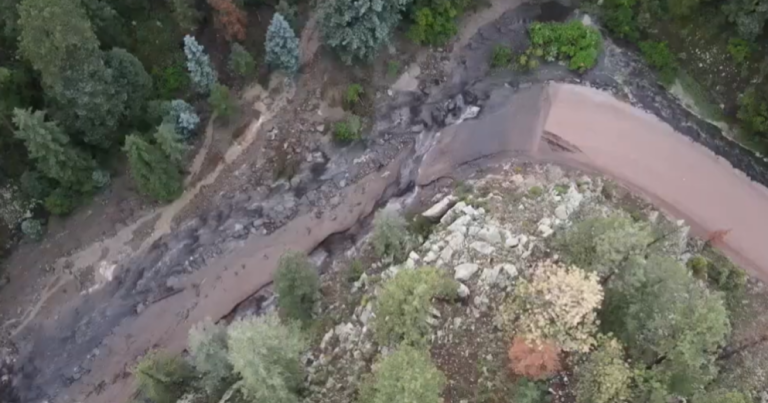
Two people died and one home was destroyed during flash floods west of Fort Collins on Friday night. Heavy rain – one to two inches per hour – fell on the Cameron Peak burn scar, and runoff flowed quickly into valleys and streams.
The flood killed an adult woman and a girl in a camping trailer that was washed away from the middle to upper Buckhorn area. Their bodies were found about two and a half hours after the first reports of flooding.
“Last night was definitely a demonstration of what can happen in a burn area, and how fast flooding can occur,” said Lori Hodges, director of emergency operations for Larimer County.
Even long after the flames are gone, residents face a serious increase to the threat of flooding.
Around 5 p.m., the Larimer County Sheriff’s Office received multiple reports of flash flooding near Glen Haven and Crystal Mountain. First responders found some flooding in both areas, including washed out private bridges and culverts. Officials said some roads are impassable for cars but still walkable, meaning that nobody is completely cut off.
Hodges said the flooding could have been more destructive near Glen Haven, but highlighted mitigation measures as a “success story.” Homeowners worked with the county to install flood barrier bags, essentially giant tubs of sand, that protected their properties from rising water that carried debris.
A contractor hired by the county to clear debris from the area on Saturday said the flooding mostly consisted of water and wooden debris. Larimer County officials said they would not categorize the event as a mudslide.
When rainwater hits a burn scar, the soil is dead and ashy – unable to absorb water normally. Instead, it flows on the surface, quickly making its way downhill. That runoff also carries wooden debris, which can clog up waterways.
2020’s Cameron Peak Fire still stands as the largest in Colorado’s history, and crews have been working since then to protect the people and buildings still in the burn scar. Across thousands of acres, helicopters have dropped mulch on burned areas in an attempt to stabilize the soil and promote restoration. Officials said any aerial mulching work near the flooded areas would not have stopped flooding, since not enough time had passed to allow regrowth of soil and plants.
Destructive flooding occurred almost exactly a year ago in another part of the Cameron Peak burn scar, killing at least two people in Poudre Canyon.
Scientists warn that climate change is only likely to make wildfires and floods more frequent and intense. Warming temperatures and extended drought have caused wildfires to burn more quickly, and during times outside of the traditional “fire season.”
This story is part of ongoing coverage of water in the West, produced by KUNC in Colorado and supported by the Walton Family Foundation. KUNC is solely responsible for its editorial coverage.
